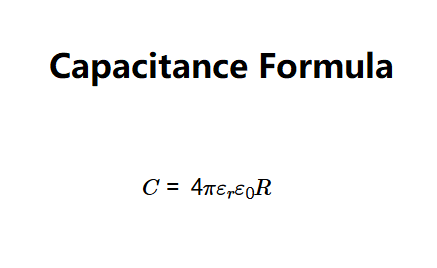 Home
Home
 Back
Back

Definition: This calculator computes the capacitance (\( C \)) of an isolated spherical shell based on its radius (\( R \)) and the dielectric constant (\( \varepsilon_r \)) of the surrounding material.
Purpose: It is used in electrical engineering and physics to determine the capacitance of spherical conductors, which is relevant for applications like electrostatic shielding, spherical capacitors, and theoretical studies of charge storage.
Capacitance is calculated using:
Radius conversions:
Explanation: The input radius (\( R \)) is converted to meters, and the dielectric constant (\( \varepsilon_r \)) is used as a unitless value. The permittivity of free space (\( \varepsilon_0 \)) is \( 8.854187817 \times 10^{-12} \, \text{F/m} \). Capacitance is calculated in farads (F) and then converted to microfarads (µF), nanofarads (nF), and picofarads (pF) for display. Small values are shown in scientific notation for clarity.
Details: Capacitance determines how much charge an isolated spherical shell can store for a given voltage, which is important in applications like electrostatic shielding, spherical antennas, and theoretical models in electromagnetism. It also helps in understanding the behavior of spherical conductors in electric fields.
Tips: Enter the radius (\( R \)) in m, cm, mm, or in (must be greater than 0), and the dielectric constant (\( \varepsilon_r \), must be at least 1). The result will be the capacitance in farads (F), microfarads (µF), nanofarads (nF), and picofarads (pF). Values less than 0.00001 will be displayed in scientific notation.
Examples:
Q: What is the dielectric constant (\( \varepsilon_r \))?
A: The dielectric constant (\( \varepsilon_r \)) is a unitless value that represents the permittivity of the material surrounding the spherical shell relative to the permittivity of free space. For air or vacuum, \( \varepsilon_r \approx 1 \); for materials like glass, it’s around 3.9; for ceramics, it can be much higher.
Q: Why must the radius be greater than zero?
A: The formula requires a positive radius (\( R \)). A zero radius would result in a capacitance of zero, which is not practical for a spherical shell.
Q: Why must the dielectric constant be at least 1?
A: The dielectric constant (\( \varepsilon_r \)) is a relative measure compared to free space, where \( \varepsilon_r = 1 \). Values less than 1 are not physically meaningful for real materials in this context.
Q: Why are small values displayed in scientific notation?
A: Values less than 0.00001 (e.g., \( 1 \times 10^{-5} \)) are displayed in scientific notation for clarity, as they are very small and would otherwise show as long strings of zeros in decimal format (e.g., 0.000000000111267 F becomes \( 1.112667e-10 \, \text{F} \)).
Q: Why is the result displayed in multiple units (F, µF, nF, pF)?
A: Isolated spherical shells often have very small capacitances (e.g., in the picofarad range). Displaying the result in farads, microfarads, nanofarads, and picofarads provides flexibility for different applications, as practical capacitor values are often in µF, nF, or pF.